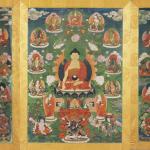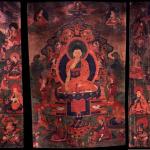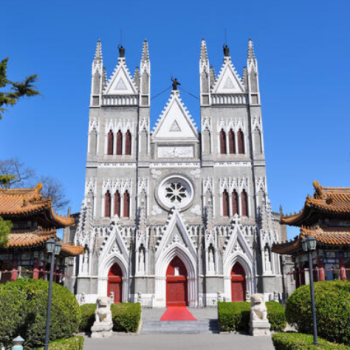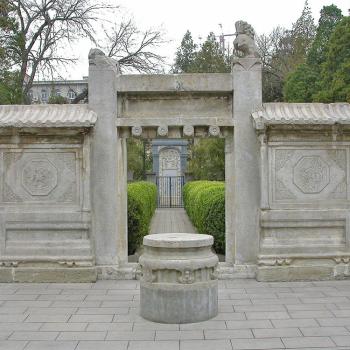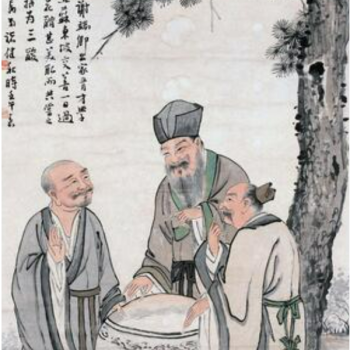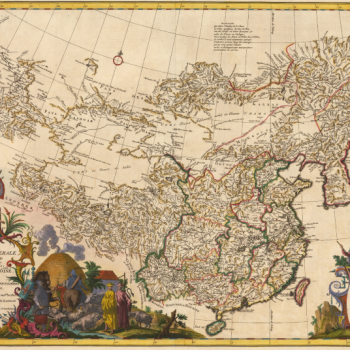The decades following the publication of the Huangji jieguo baojuan would see two key events fundamentally reshape the landscape of Chinese sectarianism. The first of these was the emergence of one of the most extraordinary figures in the history of Chinese religion, a radical reformer who came to be known as Patriarch Luo. The second was the displacement of the Primordial Buddha in sectarian thought by a new supreme deity. How much these two occurrences were linked is difficult to say. But their close proximity in time was certainly fortuitous because, when joined together, the new deity and the teachings of Patriarch Luo launched Ming sectarianism into a whole new phase and launched the sectarian boom of the sixteenth and seventeenth centuries.
Patriarch Luo’s real name remains a matter of debate. While his surname was certainly Luo, sources disagree as to his given name. Scholarly consensus in the last century settled upon Qing as his personal name but Hubert Seiwert, in Popular Religious Movements an Heterodox Sects in China, makes the compelling case that it was actually Menghong, and two-character given names were certainly more common than one-character ones by this time. Regardless of whether he was named Luo Qing or Luo Menghong, the future patriarch hardly seemed destined to alter the Chinese religious landscape. Born in 1443 in Shandong Province, Luo was orphaned in the first years of his life and was raised by his aunt and uncle. When he came of age, he took up his family’s hereditary occupation and enlisted as a soldier, spending his career at a Great Wall garrison just north of Beijing. Under normal circumstances, that is where he would have remained for the rest of his life.
However, there was great distress in Luo’s soul. The death of his parents when he was a child had inflicted a deep psychological wound. He felt profoundly alone and isolated in the world. He lacked a sense of rootedness and felt as there was nowhere that he truly belonged. This feeling of displacement quickly took on an existential cast, as Luo realized that he had no idea where his soul had come from, what form it would be reincarnated into next, and where it would ultimately go. His fear of having no true home deepened into profound spiritual terror. Western readers will be quick to hear echoes of Christ’s famous lament, “Foxes have their holes and birds their roosts; but the Son of Man has nowhere to lay his head” (Matt. 8:20 and Luke 9:58), in Luo’s own sorrowful remarks:
Oxen give birth to oxen, and horses to horses – they all have parents; why is it only I, this little soul, who have none?
Travelers who leave their native districts return to their homes; why is it only I who have no native place (chia-hsiang)? In the whole wide earth, men and women all have parents; why is it only I, this little soul, who have none? (qtd. in Overmyer 97).
Overcome by anguish, Luo set out on a thirteen-year spiritual journey to find the answers he needed and the sense of belonging he sought. Over the course of this time, he availed himself of every religious practice that crossed his path, only to discover that none of them lightened his melancholy and despair. He attempted to apply the principles of internal alchemy promoted by the Taoists but never achieved the promised inner transformation. He attached himself to a teacher of the Pure Land school, devoted to the bodhisattva Amitabha, who tried to heal his trauma by telling him that “Amitabha is the eternal father and mother.” This failed to work because Luo could not convince himself that Amitabha actually heard him when he prayed. Luo then took up reciting the Ritual Amplification of the Diamond Sutra for three years; while he respected the book, it did little to relieve his ennui and distress. He took up Buddhist seated meditation but found it deadening. He looked into a variety of folk practices and found them all useless. Finally, Luo was forced to the terrible conclusion that all the religious beliefs and practices of his own day “were not real [and that they] provided no place of refuge” (qtd. in Overmyer 99). His quest had seemingly ended in failure. None of the many methods, theories, or rituals that dominated the religious landscape could put his soul at peace.
In the end, the answer came to him not as the result of his years of wandering and effort but as a sudden realization:
Then suddenly I penetrated through to emptiness [and realized] that before there were Heaven and Earth there was unmoving emptiness, with no borders and limits, unmoving and unwavering, the Dharma body of all the buddhas. Heaven and Earth will decay, but emptiness does not decay; it is the Dharma body of all the buddhas. (qtd. in Overmyer 99)
The idea that “all is emptiness” is fundamental to Buddhism but has been interpreted in different (albeit not mutually exclusive) ways. The standard version that any new student of Buddhism receives is that everything is emptiness because nothing in the world has an independent existence. Everything in existence—be it objects, persons, or our moods and mental states—comes from something else, depends upon other things to exist, and is itself made up of other things, which are themselves also dependent upon and constituted by other things. There is no fundamental nature or suchness that you can point to which makes a thing itself and not merely a conglomerate of other units and variables. A table is not inherently a table but is a group of wood pieces assembled together into a particular shape, and those pieces of wood are themselves not inherently pieces of wood but are simply a certain arrangement of individual fragments, splinters, cells, molecules, atoms, and so on. Thus everything is empty because everything lacks on inherent nature and existence of its own, relying entirely upon other things to exist.
Besides this standard definition—and again, not inherently opposed to it—there is also a more mystical understanding of emptiness. The idea here is that if you keep dividing things and finding that they are constituted by other things, you must hit bedrock eventually. There must be a base level where you cannot divide any longer and instead find out what it is that makes up all the other things in existence. Thus, emptiness becomes the foundational principle and fundamental nature of the cosmos. It can even be thought of, if one is willing to go that far, as a kind of primordial essence. It is not empty because it does not exist, it is empty because no descriptions or distinctions can be applied to it, since it came before them all. Emptiness is the fundamental unity and singularity from which everything emerged, to which everything will return, and which ultimately constitutes everything that exists.
It is this monistic understanding of emptiness that Patriarch Luo was suddenly awakened to. But at first, it was only an intellectual awareness. He understood the concept in theory and this brought him some relief. But he did not yet experience it as a lived reality. In his lived experience, except at rare moments of ecstasy, he was still too caught up in the apparent distinctions of the phenomenal world. That all changed when he had a second moment of awakening:
While facing southwest, sitting upright, absorbed in meditation, suddenly the flower of my mind blossomed, the foundation of my mind opened up, and [I obtained] a penetrating understanding of the underlying brilliant light. Finally I attained that state of spiritual autonomy and freedom everywhere; finally I attained freedom, peace, and security. (qtd. in Overmyer 100).
This mystical experience allowed Patriarch Luo to grasp the concept of emptiness on more than just an intellectual level. He now had a perceptual awareness of it as the source of everything around him. All things in his life he could now effortlessly recognize as being manifestations of emptiness. Emptiness had truly become a lived reality for him; this at last is what finally cured him of his loneliness, sense of isolation, and rootlessness. He now felt that he belonged in the world, that he was rooted in the fundamental essence of all things, and that he knew where he had come from and where he was going. Immediately, he sought to communicate his insights to others and became a spiritual teacher, creating what would turn out to be the largest and most popular new religious movement of the Ming era. Luo wrote down and codified his teachings into a series of baojuan, published in 1509 as the Five Books in Six Volumes, and when he died at the age of eighty-five in 1527, an ornate pagoda was erected beside his tomb with memorials written by Buddhist monks, a Taoist priest, and officials of the government.
Patriarch Luo’s influence upon the Chinese religious landscape was profound and can still be felt to this day. His central teaching was that all things share a fundamental essence, emptiness, which ultimately constitutes their true nature. All are one with emptiness and it is by realizing this fundamental oneness that an individual is able to escape suffering and attain enlightenment or salvation. As he exhorts his listeners, “You yourself are real; the myriad things are empty. Your nature is real. Your nature existed before creation; why don’t you take responsibility for it now?” (qtd. in Overmyer 123). This idea in itself was not new. It had a long history in Buddhism and is the core doctrine of the Chan school, better known in the West by its Japanese name of Zen. However, Luo took the notion in a much more radical direction than had ever been done before. Not only did he go further than the Chan teachers by taking the idea in a more fully monistic and, it would turn out, pantheistic direction, he also used it as the basis to attack Buddhism’s foundational understanding of the relationship between religious practice and progress toward enlightenment.
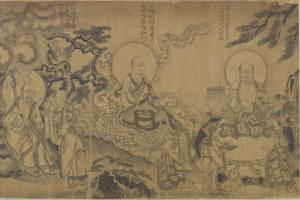
The Chan Buddhists may have emphasized that enlightenment experience consists of a sudden realization of fundamental emptiness, but they still upheld traditional Buddhist practices as a means of getting there. But Luo, drawing upon his own failed efforts at finding peace within a framework of practice and ritual, declared all forms of conventional religion invalid. For Luo, all these rituals, techniques, and forms of devotion were useless for achieving enlightenment: “To be a monk or a layman, to sit in meditation, receive the percepts, recite scripture, eat vegetarian food, worship at [Mount] Wu-t’ai … print scriptures and make images—all this is to manipulate puppets. When [at death] one’s breath is cut off, [with such practices] one will seek in vain for a path of escape,” (qtd. in Overmyer 116) This attitude extends even to morality itself. Luo deems a moral life and helping others to be both unnecessary to enlightenment and a potential roadblock on the path, “The five precepts and the ten precepts are the road to birth-and-death; those who cling to doing good acts [for their salvation] fall into sāmsara,” (qtd. in Overmyer 114). He was not a moral anarchist, as he still expected his own followers to behave morally, help each other, and maintain a vegetarian diet. But none of these things would lead to liberation from suffering. Instead of focusing on them, people should recognize that they themselves are manifestations of primordial emptiness and at one with all things. It is only this insight, which can be attained by anyone anywhere at any time, and no amount of religious practice or good works that will bring about enlightenment and spiritual freedom.
Thus, Luo had taken the mystical Buddhist idea of emptiness and followed it to a conclusion more extreme than anyone had before him by rejecting traditional religious practice and morality. But this was not the only radical conclusion he drew. A realization of the primordial unity and emptiness naturally required one to see the distinctions in the world, the different qualities of things, as illusionary and unreal. This concept was normally only applied to the phenomenal realm, but Luo applied it to the social one as well:
Only because you make distinctions (fen-pieh) is there birth-and-death. If you would only return to the [inner] light, everything would be complete and fulfilled. The mind is the Buddha, the Buddha is the mind; originally they were not two. It is ignorant people, whose faith doesn’t go far enough, who seek on the outside. Those who remain at home and those who have left the household life all have [this light]; men and women, women and men, can all [attain] complete fulfillment. (qtd. in Overmyer 114)
For Luo, rejecting distinctions meant not just denying that there were differences between different types of phenomena, but also that there were differences between monks and laypeople—“those who have left the household life” refers specifically to individuals who have entered a monastery—and between men and women. Social ranks also were meaningless. Everyone is equally a manifestation of emptiness and everyone has the equal ability to realize this and attain enlightenment. Patriarch Luo’s religious vision is profoundly egalitarian; differences of rank, gender, and religious devotion are not real. All are equally children of emptiness and if they could only realize that, salvation would be theirs.
This egalitarian ideal was one which Luo made steps to put into practice in his own sect. He was himself a layman and, despite his status as an influential religious leader, never took vows or pursued any form of ordination. He encouraged his followers to treat each other as siblings regardless of rank or wealth. When he died, his wife became leader of the sect and his daughter would later found her own offshoot—women holding leadership positions was a feature of his movement and its descendants. What is more, while he enjoyed success with all social ranks, it was particularly amongst the poor, downtrodden, and disenfranchised that his message most resonated; his teachings found particularly great success among his fellow soldiers and the destitute boatmen of the Grand Canal. Seiwert notes how the simplicity of his teachings appealed to them: “Attractive as his teaching was for educated people, who could take it as a kind of radical Chan Buddhism, it was not intellectually sophisticated and therefore easy to understand even for the less educated … no particular knowledge of Buddhism was needed to understand it. His aim was not to propagate Buddhist philosophy nor Buddhist practice and institutions, but to communicate his own insight,” (Seiwert 229). Luo’s teaching was simple to understand and the goal of enlightenment theoretically easy to achieve. It did not require disciplined and diligent religious practice, nor demanding vows like vegetarianism or celibacy, though Seiwert does believe that Luo taught secret rituals in order to speed the process up. It denied the special authority of monks and priests and told those in ordinary life that they had an equally potent path to salvation. With these qualities, it could not fail to appeal to those outside the religious hierarchy. Both the simplicity of the message and its fundamental egalitarianism, the acknowledgement of the worth and value of those excluded from wealth, privilege, and power, both played a significant role in attracting the poor and less fortunate to Patriarch Luo and his teachings.
With all that being said, while Luo may have been a radical, he was no revolutionary. After all, he could not have achieved such a degree of respect from the political and religious establishment in his own lifetime—recall the memorials of public figures and religious officials at his tomb—had he taken the antinomian and egalitarian ideals presented in his texts too far. Working out the most extreme implications fell to those who came after him. In this sense, he was much like Joachim in that in his own lifetime he was viewed as a respected teacher who was seen as elucidating long-established beliefs (in Luo’s case, Chan Buddhism), but after his death the radical and potentially transformative nature of his ideas came to the fore as the writings and actions of his followers prompted an official backlash. Joachim’s ideas were declared heretical by the Catholic Church. Luo’s own were declared heretical by state-sponsored Buddhism. While the Ming Dynasty (with a few high-profile exceptions) tolerated Luo’s movement and its various offshoots, the subsequent Qing Dynasty banned Luo’s writings, persecuted his followers, and levelled his tomb.
But just as in Joachim’s case, the authorities were already too late to stop the spread of Luo’s teachings. Although Luo lived and taught entirely in the capital region in the north, his works had already reached southern China a generation after his own lifetime. By the time political and religious authorities turned a critical eye toward them, the teachings of Patriarch Luo had spread throughout China. Subsequent persecutions did not root them out. Instead, they only served to limit the influence of Luo’s teachings in official circles and leave his legacy entirely in the hands of the sectarians.
At first glance, the figure of Patriarch Luo seems to fit oddly into the story of Ming sectarianism as a whole. He is universally regarded as the single most influential figure in the wider sectarian movement and yet it is striking how few of its core beliefs derive from him. As we have seen previously, the sectarian movement of the Ming and Qing periods was resolutely messianic and millenarian, expecting the imminent advent of Maitreya, the end of the present world-order, and the birth of a new, utopian one. By the time of the Huangji jieguo baojuan, this expectation had taken the form of a detailed system of three temporal ages reminiscent of Joachim’s own. But just as he had been radical without being revolutionary, Patriarch Luo was also mystic without being a millennialist. He never spoke of the three ages and explicitly rejected belief in Maitreya’s coming arrival as another false teaching that prevented true enlightenment. Thus, the defining belief of the Ming and Qing sectarians finds no place in Luo’s system. Indeed, in this sense the prevailing sectarian ethos influenced his movement rather than the other way around. Within a generation of his passing, his own followers had adopted the messianic version of Maitreya that he had rejected and the accompanying notion of the three ages. What is more, despite Luo’s own insistence on the meaninglessness of rituals, Luo’s later adherents would follow the lead of other sectarians and adopt elaborate esoteric rituals as a key part of their practice. These concepts, so different from what Luo himself had preached, have nonetheless remained a key part of Luoism ever since.
And yet, for all this, Luo’s fingerprints are all over Ming sectarianism. His own movement’s adoption of Maitreya and the three ages became one of the vectors by which those ideas were transmitted even more widely. Many of the most influential Maitreyan and three-ages sects of later times either emerged out of the Luo movement or claimed to have done so, acknowledging Luo as one of their own patriarchs. He even influenced the form in which those ideas were expressed. Though later baojuans largely follow the same structure and present many of the same ideas as the Huangji did, they do so in language derived from Patriarch Luo. Terms and descriptions Luo had popularized to describe his own process of enlightenment, such as “returning to the native place,” “seeing the original face,” or “becoming free and independent everywhere” became part of the standard vocabulary of later baojuans. These terms would appear in sectarian contexts again and again for centuries, and Patriarch Luo deserves much of the credit for that.
The popularity of the baojuan format as a means of conveying spiritual truth itself owes much to Patriarch Luo. It was once common to regard him as the founder of the entire genre and innovator of the form. The discovery of the Huangji put this idea to bed by demonstrating that the genre’s most distinctive features had been established long before he took up writing. Still, Patriarch Luo’s baojuans had the farthest reach of any and did much to popularize the template among future sectarian visionaries. As the first baojuan author to publish under his own name, Luo did much to legitimize the medium and his success proved how effective they could be at getting a message across. And as the first baojuan author to attain a high level of celebrity, he became an attractive figure for later writers to imitate. Many later sect leaders wrote their own Five Books in Six Volumes and often cribbed book and chapter titles from Luo, even as they ignored everything he wrote in those books and chapters. On a literary level alone, the influence Luo exerted on later sectarians was profound.
But he influenced them in other ways as well. None of these was perhaps more important than in the antinomian and egalitarian aspects of his vision. As we have seen previously, a distrust of the official religious hierarchy had always been a part of Chinese eschatology. This was often accompanied by basic gestures toward the erasing of class and gender differences, at least among the chosen “seed people.” We have seen too that a more developed, if still somewhat inchoate, egalitarian subtext had already existed in the Huangji. However, Luo gave a boost to this natural tendency; the egalitarian dimensions of later baojuans and their attendant sects would be far more pronounced and overt than they had been previously. Many sects would even be led by women, just as Luo’s had been in the wake of his death. Again, we cannot conclude from this that Luo alone pioneered female succession but the example of his sect no doubt helped to popularize it among the Ming sectarians.
Patriarch Luo might, again like Joachim, best be described as someone whose influence is the ideas his works inspired in others, even as they differed from his own. He was not the founding figure of Ming sectarianism, as earlier generations of scholars had thought, but it is undeniable that he colored all that came after him. Later Ming and then Qing sectarianism could be seen as the system of the Huangji reinterpreted through a Luoist lens. Oftentimes, this resulted in something strikingly new, beyond both what Luo and the Huangji’s own authors had intended. That was never truer than when it came to what is perhaps Patriarch Luo’s greatest legacy among later Ming sectarians: the figure of the divine Mother.
To understand Luo’s influence here, however, we have to return to his understanding of fundamental emptiness and what makes it so radical. Luo did not just depart from Chan orthodoxy in the social implications he drew from the view that emptiness underlies everything. He also diverged from them in how he understood emptiness itself. For him, emptiness was not simply a convenient way of understanding interlocking webs of relationships and was much more than our basic universal nature. For Luo, as Seiwert says, emptiness was both “a creative principle that has brought forth all that exists through his own transformation” (221) and a pantheistic deity capable of feeling things such as love, pity, and compassion. It cares about the sentient beings that have arisen out of itself and even manifests as historical personages such as Gautama Buddha—Overmyer notes that “it is interesting that four of the manifestations here are as ‘worthy women’” (Overmyer 121)—in order to help them escape suffering. Luo represents emptiness in many forms in order to better convey this kind of agency and individuality. Some of these included Venerable True Emptiness or the Holy Patriarch of the Limitless. But by far the most influential of his divine personifications was that of the Mother.
It was logical that he should make the association with motherhood. After all, he understood emptiness as producing all of reality from within itself. What more apt metaphor for this was there than a mother producing children? As Luo puts it, “All these names flow out of a single character. This character is Mother (mu). The Mother is the Patriarch and the Patriarch is the Mother” (qtd. in Seiwert 221). Certainly, as far back as the Daodejing, there was precedent for describing the ultimate principle and ground of reality in maternal terms. But beyond that, the image of emptiness as Mother resonates so much in Luo’s writings because it recalls the loss of his own parents. It was the death of his mother just a few years after his birth that first instilled the sense of rootlessness and not belonging anywhere in a young Luo, so it was only fitting that his discovery of his true roots and that he belongs to the whole universe should be presented as a reconciliation with a greater, cosmic Mother: “[There is no need to] take refuge in being or nonbeing; I am true emptiness (wo shih chen-k’ung). The Mother is I [= the self] and I am the Mother (niang shih wo, wo shih niang); fundamentally there is no duality. Empty within and without, I am true emptiness,” (qtd. in Overmyer 100). If Luo’s spiritual journey was in some sense a quest to find something to replace the mother he had lost, imagining emptiness itself as his true mother is a particularly poignant way of letting his readers know that his quest has been achieved. It also speaks to the great admiration he had for women that he should see the supreme deity of the universe in feminine terms and include famous women among its many manifestations. Truly, in his image of the Mother, he had both valorized femininity and crafted a powerful symbol for the safety, security, and stability he had found in the loving embrace of fundamental emptiness.
What is remarkable is that Patriarch Luo was not doing this in isolation. For his choice to depict his one God as a benevolent and loving mother dovetailed, intentionally or not, with the second major change that occurred in Ming sectarianism around the turn of the sixteenth century. As noted to in our previous entry, by Luo’s time, the sectarians already had a vision of a pantheistic God who was both the fundamental essence and original creator of the universe. This was, according to the Huangji, the Primordial Buddha. But around the time that Luo was disseminating his Five Books in Six Volumes, the Primordial Buddha was knocked off his perch as ruler of the cosmos. The sectarians en masse adopted a new supreme deity, one imagined as far more feminine and maternal than the Primordial Buddha—or indeed, the supreme deities of most religions. This new deity was called the Wusheng Laomu (無生老母) – the Venerable Unborn Mother.
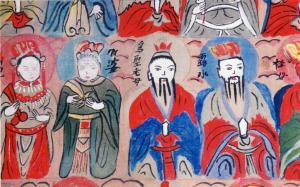
To what extent these two twin developments are connected is impossible to say. Indeed, where the Unborn Mother came from and why she caught on so quickly with sectarians remains a mystery. The first reference we have to a divine Mother figure being connected to millenarian hopes and salvation from apocalyptic turmoil is surprisingly ancient, dating to 3 B.C.E. In the last years of the Western Han Dynasty, with Wang Mang’s usurpation just over a decade away, the ruling regime already seemed to be tottering on the brink of collapse. At this time, an apocalyptic movement appeared centered on the figure of the Queen Mother of the West, long a popular figure in Chinese mythology who presides over a western paradise and grants immortality. This movement, which took the eastern provinces by storm and spread to the capital, proclaimed that a demonic barbarian army—surely the predecessors of the “Old Moon” of medieval Buddhist eschatology—was about to sweep across the land and slaughter everyone. However, followers of the movement were given tablets that proclaimed, “The Mother informs all people that those who carry this writing will not die” (qtd. in Seiwert 32). They expected that the Mother would intervene to rescue them from the coming calamity, probably by whisking them to her paradise and making them immortal.
In this sense, this movement’s conception of the Queen Mother of the West quite resembles the Venerable Unborn Mother of the Ming and Qing sectarians. Both are maternal figures who are expected to save their followers from the apocalyptic end of the world. Both will accomplish this feat in roughly the same fashion, delivering their devotees into a paradisal realm beyond the devastation and providing them with eternal life. Indeed, the Unborn Mother’s paradise, despite being a heaven outside the cosmos, was often referred to as the “Western Realm” and contrasted to the “Eastern Realm” of the mundane world, which could be interpreted as a holdover from that fact that the Queen Mother’s paradise was supposedly located to the west of China.
Another intriguing note is that the Queen Mother sect of 3 B.C.E., had its origins in the vicinity of Shandong, which over a millennium later would see the birth of Patriarch Luo and be the homebase for a number of the later Mother-revering sects—the northeast had been a hotbed of millennialist sentiment since the earliest days of Chinese apocalyptic thought. Indeed, it seems some later sectarians even explicitly equated the two figures. Given all this, and the fact that the Queen Mother of the West has remained a popular divinity in Chinese culture up to the present day, sometimes with aspects of a creator deity, it is tempting to conclude that the Venerable Unborn Mother was a direct reimagining of the Queen Mother of the West, elevated from ruler of the west to ruler of the world.
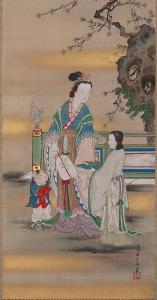
However, Seiwert advocates caution. While noting the obvious similarities between the characters, he emphasizes that the most important shared trait of the Han-era Queen Mother movement and the later worship of the Unborn Mother is their apocalyptic element; both place a premium on the Mother’s ability is to save her followers from the end of the world. Seiwert notes, “Unfortunately we have no evidence of this combination of ideas after the Han dynasty until the Ming,” (Seiwert 442). While the Queen Mother of the West never declined in popularity, she ceased to be an apocalyptic figure after the incident in 3 B.C.E. The element of end-times salvation was dropped from her story and later devotees did not worship her in order to be saved from the final calamities. The themes of end-times salvation and a divine mother dwelling in a western paradise would only be combined again quite suddenly in the Ming era, with the appearance of the Unborn Mother seemingly out of nowhere. For there to be a connection between them would require the concept of an apocalyptic mother figure to have survived continuously for fifteen-hundred years without ever being written down or recorded in that span of time.
While this is not impossible—after all, concepts of such as the “seed people” and the floating city reappeared in Ming sectarianism despite large gaps in time between mentions in written records—the massive timespan involved would make such a survival extraordinary. Instead, it might simply have been the case that, since the previous supreme deity of the Ming sectarians was identified with Amitabha, known for ruling his own western paradise, the adoption of the Queen Mother as cosmic ruler seemed logical to the sectarians, and they only by coincidence reproduced the main theme of a movement that had existed long before their own time. After all, As Seiwert says, “To return to the Native Place joining the Eternal Mother was not very different from being reborn in Amitābha’s Western Paradise” (474-75). As it stands now, without further linking evidence, the question of how the Unborn Mother relates to the earlier apocalyptic form of the Queen Mother of the West remains an open and perplexing one.
But there is another source of inspiration for the Venerable Unborn Mother, one whose role in creating the figure is much surer but also far stranger. For the Unborn Mother might be the first supreme deity ever conceived due to the popularity of a common idiom. This all seems to begin with The Hymn of the Venerable One from Sichuan, a text we encountered in our last entry. I had noted it there primarily to emphasize that Sichuan was still associated with millenarian ideas in the popular mind in the time of the Ming Dynasty but, in truth, it made an important contribution of its own to Chinese eschatology. This contribution was the phrase, “little children will see their mother” (ying’er jian niang 嬰兒見娘). Seemingly innocuous on the face of it, this little saying would have an outsized legacy on sectarian and apocalyptic thought in China.
The meaning of the phrase was originally entirely metaphorical. It did not originally refer to an actual reunion between children and their mother but to a state of pure and transcendent joy experienced when one achieves enlightenment or salvation. It was an apt comparison to make for two reasons. One was that the joy of spiritual freedom was so vast and profound that the only earthly experience that could come close to it was that of a loving parent and child seeing each other again after a long period of absence. The other was that, in Chinese culture, both enlightenment and salvation were imagined as a return to one’s own primordial origin. Thus, just as in Patriarch Luo’s case, it made sense to poetically refer to the recovery of the source of one’s being as a reunion with the mother that had birthed them.
It remained a poetic and metaphorical expression of spiritual liberation for centuries. The Ritual Amplification of the Diamond Sutra (traditionally dated from the tenth century, but Overmyer accepts Sawada Mizuho’s proposed date of 1242) used it to describe the moment of enlightenment, imagined here as in much of Chinese Buddhism as a rediscovery of the seeker’s original and uncontaminated Buddha-nature. The Huangji jieguo baojuan, the subject of our last entry, also used the phrase two centuries later in 1430. Here, “the little children will see their mother” now referred to the joy of the saved when they enter into heaven and come face to face with Maitreya as he prepares to take control of the earth. This gave the phrase an eschatological meaning that would quickly become its primary one, as ever afterward “the little children will see their mother” would be a shorthand in the baojuans for the joy believers would feel upon witnessing the birth of the third age and the coming of Maitreya’s messianic reign.
However, “the little children will see their mother” had one final permutation to undergo. For a span of about three centuries, it had remained a metaphor and had not been taken literally as referring to an actual meeting between a mother and her children. That all changed around the beginning of the sixteenth century. Despite his own penchant for personifying the source of all as a divine mother, Patriarch Luo quoted the phrase contemptuously, denouncing “the ignorant people who say that the original nature is the little child and that Amitābha is the Eternal Father-Mother” (qtd. in Overmyer 395, n. 30, with slight emendation to preserve Luo’s literal meaning). Beyond his derision, this reveals that by Luo’s time, the phrase being used in a more literal sense to describe a meeting with Amitabha in his paradise in the afterlife.
However, as we have noted, the Ming sectarians soon ditched Amitabha as their supreme deity entirely. In his place, they adopted a very literal interpretation of the phrase “little children will see their mother.” Now, the supreme deity actually was the mother mentioned in the idiom, for she was the Wusheng Laomu, the mother of us all. Later baojuan of the Ming and Qing eras presented her as not only the ruler and creator of the cosmos, but as the actual mother of humanity who wept constantly for the loss of her children into the world and wanted nothing more than for them to eventually return home. The eschatological dimension of the phrase remained intact but it now gained a new and more literal edge. For the coming of the third age, when Maitreya took up his rule and the world was reborn as a paradise, would be a kind of homecoming. As the apocalyptic disasters of the transition period began to ravage the world, the believers would be caught up into the heavens and would be delivered into Wusheng Laomu’s presence, there to wait out the destruction below and witness the dawn of the new age. The Unborn Mother’s love, constant and abiding, would define the world of the time to come and humanity would never again experience the pain of separation from it. Thus, the literal meaning of the phrase would come true and the “little children” would actually see their mother. The joy of salvation remained but the reunion it promised was now not a metaphor but a real event.
As a sidenote, it is hard to write about the history and meaning of the phrase “little children will see their mother” without bringing to mind Paul Simon’s famous song, “Mother and Child Reunion.” Interestingly enough, there might actually be a connection between the two. Paul Simon has said that he came up with the title of the song after seeing the phrase in a menu of a Chinese restaurant. Of course, its use there—not to mention in Simon’s song—had no eschatological associations, it simply described a dish on the menu. But because the Chinese sectarians were most successful outside of elite circles and managed to attract relatively large followings, many of their favorite phrases entered the common vernacular of the general populace. As such, idioms with origins in sectarian and apocalyptic thought would continue to be used by the Chinese public long after their original meanings had been forgotten. In addition, ying’er jian niang can with equal validity be translated in the singular as “the small child sees its mother,” which gets us very close to the title of the song. For my money, the “mother and child reunion” that Simon saw on the menu that day was a distant survival of “the little children will see their mother,” meaning that the phrase that did so much to shape later Chinese eschatology also had a small, albeit utterly different, influence on modern Western culture as well.
Thus it seems that a simple phrase, possibly buoyed by folk memories of an apocalyptic form of the Queen Mother of the West and the already extensive devotion to Amitabha, gave birth to the new supreme goddess of Chinese sectarianism. Of course, there is still one other possible source for the figure of the Unborn Mother, and that is Patriarch Luo himself. After all, he was pioneering the use of “Mother” to refer to the supreme ruler and primordial essence of the universe at about the same time the millennialist sectarians began worshipping the Venerable Unborn Mother as their new deity. Even given his own rejection of the phrase, “little children will see their mother,” the celebrity and influence he wielded even within his own lifetime makes it reasonable to assume that his teachings played a role in the adoption of the Mother as chief deity by the sectarians.
Even so, he certainly could not have been the sole source of inspiration. After all, Luo’s Mother might share the same basic function as the Wusheng Laomu, but in many respects it was still a very different conception. Seiwert contrasts Luo’s version with that of a later figure name Mingkong, who professed to be a follower of Luo but was much closer in belief to the mainline of sectarian thought. Seiwert states that in Mingkong’s writings, “the symbol of the Unborn Parents, which is Luo’s writings is used in a rather abstract way, has been fully transformed into the popular image of the Unborn Mother who is described as a personal deity full of compassion for her lost children” (Seiwert 246). In short, much of the nuance of Luo’s conception, where the Mother could both be described as a divinity and in more monistic terms reminiscent of Chan Buddhism, was lost. What is more, Luo’s Mother, like the early modern form of the Queen Mother of the West, lacks the apocalyptic dimension so characteristic of the Wusheng Laomu. Indeed, given how much she resembles the earlier Primordial Buddha and Amitabha, the Venerable Mother seems to have arisen from precisely those parts of the sectarian thought that Patriarch Luo rejected.
And yet, given the high regard Patriarch Luo was held in by later sectarians, his concept of the Mother must certainly have left some traces on the development of the Wusheng Laomu. In some ways, later depictions of the figure seem to draw from Luo’s understanding of emptiness as the universal essence and mother of everything. Take, for instance, Seiwert’s description of Mother belief amongst the Huangtian dao / Huantiang jiao (one of the most famous three-ages sects), “In the human mind, the qi of the Primordial Beginning can be found, which is the Mother. Therefore, realization of the original unity where no distinctions are made can be experienced as mystical union with the Mother” (309). This reminds us of Patriarch Luo, with its emphasis on looking to the human mind as the source and the negation of all distinctions, seeming to indicate that at least some of the inspiration for the goddess came from him. If nothing else, the fact that such a celebrated figure had chosen to personify emptiness as the Mother must have had a legitimized the idea, giving other sectarians the warrant and permission to promote their own visions of an all-encompassing mother goddess. This suggests that here, as in so many other respects, Patriarch Luo’s contribution to later sectarianism was not so much in creating or even utilizing is distinctive forms, but in legitimizing and popularizing those forms so that others could take them down the paths he never would have ventured.
Ultimately, regardless of what effect Luo had on the formation of the Unborn Mother idea, his legacy soon became tightly intertwined with that idea and the larger mythology surrounded it. Seiwert observes that his later devotees came to regard him “as a divine manifestation of the Mother” (222) and that he soon being worshipped alongside “the Buddhas of the Three Epochs” (238). Within only a few decades of his death, Luo and his thought were fully absorbed into a mythological narrative that he had wanted nothing to do with while alive. Seiwert flatly observes, “The deification of Patriarch Luo as a manifestation of the creative principle of the universe was a clear departure from Buddhist orthodoxy” (222). It was also a departure from anything Luo himself had taught; his rejection of elaborate religious trappings seems long gone. Just as Gerard of Borgio San Donnino had with Joachim in the West, Luo’s later followers defined his legacy in a manner quite different from what he himself had intended, permanently coloring how later generations remembered him.
And yet, for all that was lost, some of Luo’s antinomian ethos survived in the later sectarians. As noted, his egalitarian spirit and respect for women were continued by the sects that came after him; if anything, the fact that they now worshipped a female deity heightened their devotion to these ideals. They remained suspicious of the official religious hierarchy and continued to champion the layman as spiritually superior to the monk or ordained priest. And, of course, they continued to appeal to the disenfranchised and the lower classes, just as Luo himself had done. His influence, however distorted it may have been, was still strong. He may not have fundamentally altered the beliefs held by most sectarians but because of him, those beliefs were presented in a new light. This, alongside the addition of the Unborn Mother to the Three Ages system and the first seen in the Huangji, brought that system to maturity, giving it the form and shape it would largely maintain throughout the Ming and Qing Dynasties.
Works Cited
The Gospel according to Luke. The Oxford Study Bible, edited by M. Jack Suggs, Katharin Doob Sakenfeld, and James R. Meuller. New York: Oxford University Press, 1992. 1327-1364.
The Gospel according to Matthew. The Oxford Study Bible, edited by M. Jack Suggs, Katharin Doob Sakenfeld, and James R. Meuller. New York: Oxford University Press, 1992. 1267-1303.
Overmyer, Daniel L. Precious Volumes: An Introduction to Chinese Sectarian Scriptures from the Sixteenth and Seventeenth Centuries. Cambridge: Harvard University Press, 1999. All bracketed text is original to Overmyer.
Seiwert, Hubert. Popular Religious Movements and Heterodox Sects in Chinese History. Leiden: Brill, 2003.

